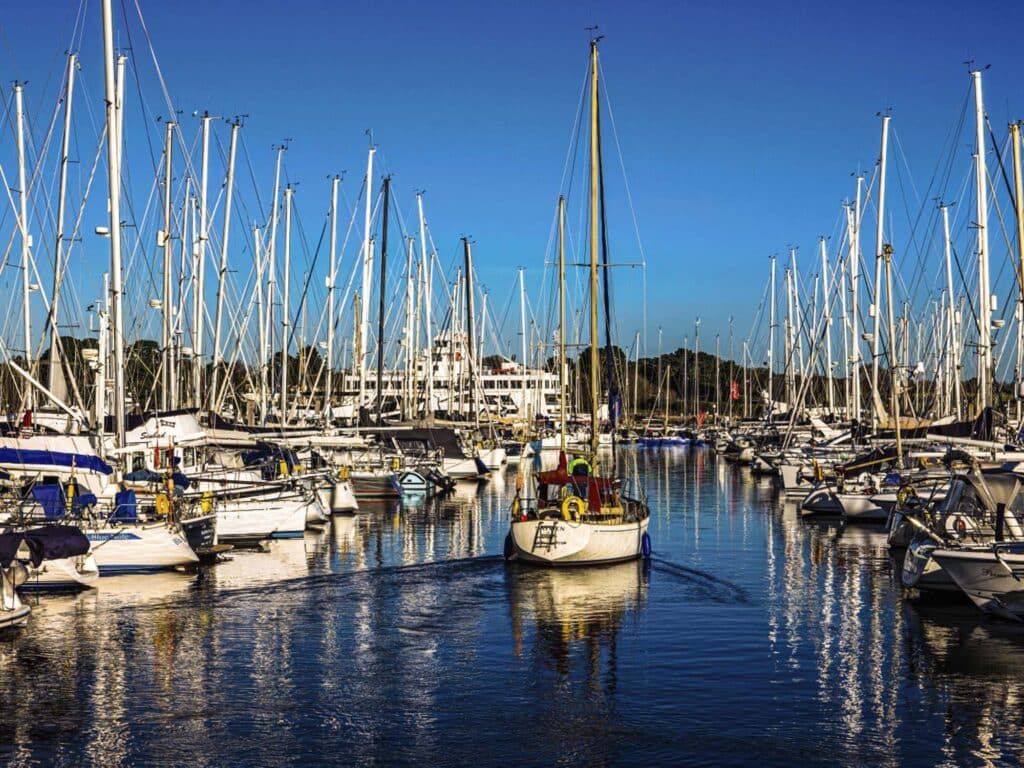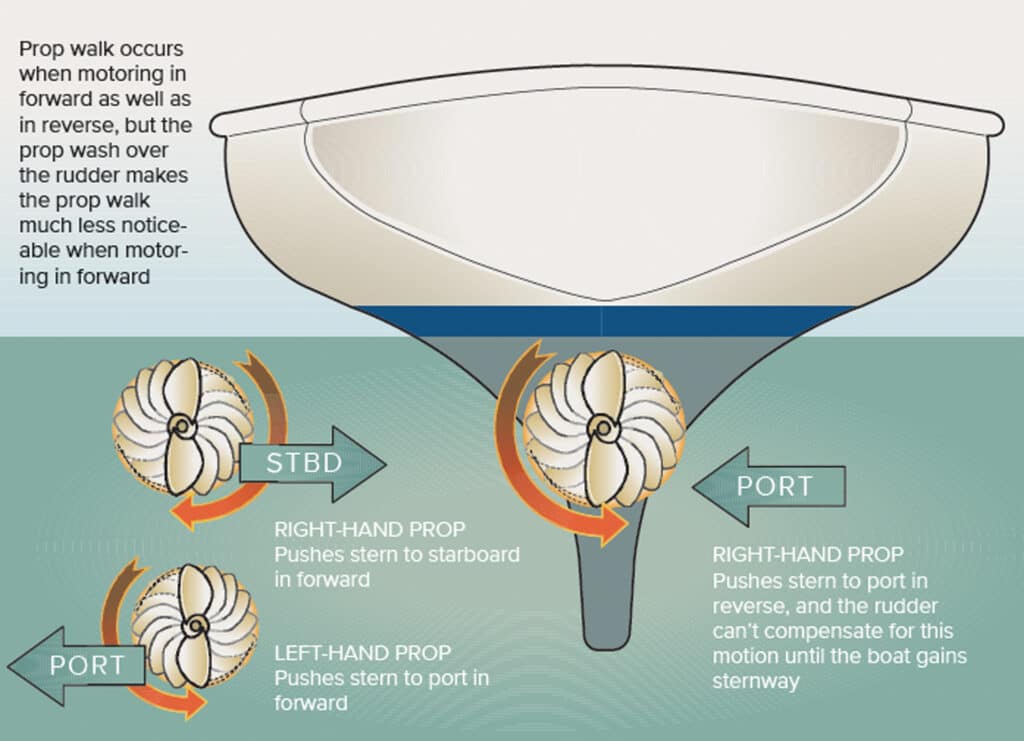
I used to get stressed out about docking, especially when a crowd was judging every step of my technique. But, after countless rounds of practicing the art of parking on water, I’ve realized that I am much more anxious about disembarking than docking. It’s the going from a dead stop that flusters my feathers, especially if there is a lot of traffic. At least when I am approaching a dock, my boat has some way, meaning I have steerage and control.
Today, I have the most manageable docking situation one could dream of. My slip is deep in California’s Marina del Rey basin. It points west into the prevailing wind and is shrouded by a row of tall buildings. Disembarking is an easy affair because the water is almost always like glass, and I never have to contend with currents or tides. I simply cast off my dock lines, push the boat back, hop on board, and turn the rudder. I don’t even use the reverse gear. I wait until I have cleared the dock, and then I shift the engine into forward just before I spin my wheel to head out.
Disembarking has not always been this easy. The trickiest scenario for me was the Nantucket Boat Basin in Massachusetts, during the Opera House Cup Regatta in August 2022, surrounded by millions of dollars’ worth of pristinely manicured wooden boats with miles of shimmering varnish. Many of the boats raft up, packing the basin so tightly that the first boat in must be the last boat out to head to the racecourse the following morning.
Simply casting off the dock lines and pushing back is not an option. Most boats have traditional underbodies, meaning they have a keel-hung rudder, and backing straight out can be a real challenge. This is even truer for the ones with an offset prop, which is a propeller that is not on centerline. These heavy, old wooden boats don’t do so well moving in reverse, even before you add the potential adverse effects of prop walk.
Prop walk occurs when a vessel is at a dead or near-dead stop. With no forward way, the sudden force of the propeller turning causes the boat’s stern to pivot laterally, also known as yaw. Understanding how this works can make you look like an absolute whiz when docking your boat in a tight situation.
The effect occurs on a majority of single-engine vessels because most have a shaft that is angled slightly downward, resulting in a propeller blade that is not oriented perpendicular to the water’s surface. The downward angle of the propeller blade results in a downstroke thrust that is less than the upstroke thrust. The differential in thrust output pushes the vessel’s stern sideways.
The effects of prop walk can vary. It’s more pronounced on boats with keel-hung rudders, but it’s still present on boats with spade rudders. Other factors, such as shallower depths and wind, can reduce its effects. Boats with saildrives should not experience prop walk because the saildrive is oriented parallel to the surface of the water.
And then, there are multihulls. Catamarans typically have an engine in each hull. They spin in different directions so that the torque balances out. As many sailors will tell you, the luxury of having twin engines can be helpful when trying to pivot any boat in tight quarters. God forbid one of the engines goes out because your steerage will then be limited mostly to turning the boat in the direction of the lost engine in forward gear, and the same when in reverse gear.
So, how does one use prop walk to their advantage? Well, the first thing is understanding the direction of spin. A right-handed propeller rotates clockwise if viewing it from the stern looking forward. A left-handed spin rotates counterclockwise. A right-handed fixed propeller will tend to push the stern of a vessel to port when in reverse, and to starboard when running forward.

How do you determine if your boat has a left- or right-handed prop? My boat has a Yanmar 2GM20F. The online engine manual confirms that the direction of rotation is clockwise. My boat has a right-handed prop.
To teach my wife, Alicia, how to use prop walk to her advantage, we motored out into the center of a channel on a day with little traffic and no wind. We brought the boat to a dead stop about two boat lengths from a channel buoy. Alicia turned the rudder hard over to starboard, shifted the engine into forward gear, and throttled up for two seconds. She then quickly throttled down and shifted the engine back into neutral.
Next, Alicia shifted the engine into reverse gear for two seconds, stopping any forward momentum. She then shifted back to neutral. Both bursts had to be quick and strong because we were trying to prevent the boat from moving forward or backward.
The prop wash encountered resistance from the hard-turned rudder. As a result, our boat began to rotate on a center pivot access to port.
Watching the buoy for reference, Alicia repeated the process multiple times, rotating our boat to 180 degrees within a boat length. We then brought our boat over to the fuel dock and tied up starboard-side to. When ready to disembark, without springing the boat, we cast off our dock lines. Alicia repeated the process we had practiced. As expected, the stern kicked out to port. She then shifted the transmission back into reverse gear, throttled up slightly, and smoothly backed our boat away from the fuel dock like a pro.
Will Sofrin is a wooden-boat builder who has sailed professionally throughout Europe, New England and the Caribbean. He is also the author of All Hands On Deck: A Modern-Day High Seas Adventure to the Far Side of the World.
Wrangling Cats
Disembarking on a catamaran requires a whole different skillset. Collin Marshall, head sailing engineer and commissioning skipper for Kinetic Catamarans in South Africa, says that he prefers to back out off the dock because the stern takes longer to get blown back in compared with the bow. This is due to the lateral resistance that rudders create, as well as the forward windage on deck from deckhouses and the mast, which is typically stepped farther forward than on a monohull.
Marshall starts by springing the catamaran forward to help kick the stern out from the dock. Then, with the stern out and engines in reverse, he splits the throttles and aims the stern in the direction he wants to go, away from the dock.
“Keep the rudders straight,” he says. “Remember that you have two engines very far apart, so forget about the rudders and wheel. That’s where people make mistakes, because they will turn the wheel and then forget to straighten it out, and then, in a pinch, they might focus on the throttles, forgetting about the rudders being turned over, adding more chaos to a situation.”
He also says that having a bow thruster (even in just one hull) can make all the difference. With that tool, he can parallel-park a 50-foot catamaran on a dime no matter where the wind is coming from. -WS








